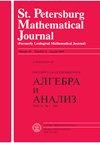求助PDF
{"title":"圆柱中势递减的Schrödinger算子","authors":"N. Filonov","doi":"10.1090/spmj/1694","DOIUrl":null,"url":null,"abstract":"<p>The Schrödinger operator <inline-formula content-type=\"math/mathml\">\n<mml:math xmlns:mml=\"http://www.w3.org/1998/Math/MathML\" alttext=\"negative normal upper Delta plus upper V left-parenthesis x comma y right-parenthesis\">\n <mml:semantics>\n <mml:mrow>\n <mml:mo>−<!-- − --></mml:mo>\n <mml:mi mathvariant=\"normal\">Δ<!-- Δ --></mml:mi>\n <mml:mo>+</mml:mo>\n <mml:mi>V</mml:mi>\n <mml:mo stretchy=\"false\">(</mml:mo>\n <mml:mi>x</mml:mi>\n <mml:mo>,</mml:mo>\n <mml:mi>y</mml:mi>\n <mml:mo stretchy=\"false\">)</mml:mo>\n </mml:mrow>\n <mml:annotation encoding=\"application/x-tex\">-\\Delta + V(x,y)</mml:annotation>\n </mml:semantics>\n</mml:math>\n</inline-formula> is considered in a cylinder <inline-formula content-type=\"math/mathml\">\n<mml:math xmlns:mml=\"http://www.w3.org/1998/Math/MathML\" alttext=\"double-struck upper R Superscript m Baseline times upper U\">\n <mml:semantics>\n <mml:mrow>\n <mml:msup>\n <mml:mrow class=\"MJX-TeXAtom-ORD\">\n <mml:mi mathvariant=\"double-struck\">R</mml:mi>\n </mml:mrow>\n <mml:mi>m</mml:mi>\n </mml:msup>\n <mml:mo>×<!-- × --></mml:mo>\n <mml:mi>U</mml:mi>\n </mml:mrow>\n <mml:annotation encoding=\"application/x-tex\">\\mathbb {R}^m \\times U</mml:annotation>\n </mml:semantics>\n</mml:math>\n</inline-formula>, where <inline-formula content-type=\"math/mathml\">\n<mml:math xmlns:mml=\"http://www.w3.org/1998/Math/MathML\" alttext=\"upper U\">\n <mml:semantics>\n <mml:mi>U</mml:mi>\n <mml:annotation encoding=\"application/x-tex\">U</mml:annotation>\n </mml:semantics>\n</mml:math>\n</inline-formula> is a bounded domain in <inline-formula content-type=\"math/mathml\">\n<mml:math xmlns:mml=\"http://www.w3.org/1998/Math/MathML\" alttext=\"double-struck upper R Superscript d\">\n <mml:semantics>\n <mml:msup>\n <mml:mrow class=\"MJX-TeXAtom-ORD\">\n <mml:mi mathvariant=\"double-struck\">R</mml:mi>\n </mml:mrow>\n <mml:mi>d</mml:mi>\n </mml:msup>\n <mml:annotation encoding=\"application/x-tex\">\\mathbb {R}^d</mml:annotation>\n </mml:semantics>\n</mml:math>\n</inline-formula>. The spectrum of such an operator is studied under the assumption that the potential decreases in longitudinal variables, <inline-formula content-type=\"math/mathml\">\n<mml:math xmlns:mml=\"http://www.w3.org/1998/Math/MathML\" alttext=\"StartAbsoluteValue upper V left-parenthesis x comma y right-parenthesis EndAbsoluteValue less-than-or-equal-to upper C mathematical left-angle x mathematical right-angle Superscript negative rho\">\n <mml:semantics>\n <mml:mrow>\n <mml:mrow class=\"MJX-TeXAtom-ORD\">\n <mml:mo stretchy=\"false\">|</mml:mo>\n </mml:mrow>\n <mml:mi>V</mml:mi>\n <mml:mo stretchy=\"false\">(</mml:mo>\n <mml:mi>x</mml:mi>\n <mml:mo>,</mml:mo>\n <mml:mi>y</mml:mi>\n <mml:mo stretchy=\"false\">)</mml:mo>\n <mml:mrow class=\"MJX-TeXAtom-ORD\">\n <mml:mo stretchy=\"false\">|</mml:mo>\n </mml:mrow>\n <mml:mo>≤<!-- ≤ --></mml:mo>\n <mml:mi>C</mml:mi>\n <mml:mo fence=\"false\" stretchy=\"false\">⟨<!-- ⟨ --></mml:mo>\n <mml:mi>x</mml:mi>\n <mml:msup>\n <mml:mo fence=\"false\" stretchy=\"false\">⟩<!-- ⟩ --></mml:mo>\n <mml:mrow class=\"MJX-TeXAtom-ORD\">\n <mml:mo>−<!-- − --></mml:mo>\n <mml:mi>ρ<!-- ρ --></mml:mi>\n </mml:mrow>\n </mml:msup>\n </mml:mrow>\n <mml:annotation encoding=\"application/x-tex\">|V(x,y)| \\le C \\langle x\\rangle ^{-\\rho }</mml:annotation>\n </mml:semantics>\n</mml:math>\n</inline-formula>. If <inline-formula content-type=\"math/mathml\">\n<mml:math xmlns:mml=\"http://www.w3.org/1998/Math/MathML\" alttext=\"rho greater-than 1\">\n <mml:semantics>\n <mml:mrow>\n <mml:mi>ρ<!-- ρ --></mml:mi>\n <mml:mo>></mml:mo>\n <mml:mn>1</mml:mn>\n </mml:mrow>\n <mml:annotation encoding=\"application/x-tex\">\\rho > 1</mml:annotation>\n </mml:semantics>\n</mml:math>\n</inline-formula>, then the wave operators exist and are complete; the Birman invariance principle and the limiting absorption principle hold true; the absolute continuous spectrum fills the semiaxis; the singular continuous spectrum is empty; the eigenvalues can accumulate to the thresholds only.</p>","PeriodicalId":51162,"journal":{"name":"St Petersburg Mathematical Journal","volume":" ","pages":""},"PeriodicalIF":0.7000,"publicationDate":"2021-12-28","publicationTypes":"Journal Article","fieldsOfStudy":null,"isOpenAccess":false,"openAccessPdf":"","citationCount":"2","resultStr":"{\"title\":\"Schrödinger operator with decreasing potential in a cylinder\",\"authors\":\"N. Filonov\",\"doi\":\"10.1090/spmj/1694\",\"DOIUrl\":null,\"url\":null,\"abstract\":\"<p>The Schrödinger operator <inline-formula content-type=\\\"math/mathml\\\">\\n<mml:math xmlns:mml=\\\"http://www.w3.org/1998/Math/MathML\\\" alttext=\\\"negative normal upper Delta plus upper V left-parenthesis x comma y right-parenthesis\\\">\\n <mml:semantics>\\n <mml:mrow>\\n <mml:mo>−<!-- − --></mml:mo>\\n <mml:mi mathvariant=\\\"normal\\\">Δ<!-- Δ --></mml:mi>\\n <mml:mo>+</mml:mo>\\n <mml:mi>V</mml:mi>\\n <mml:mo stretchy=\\\"false\\\">(</mml:mo>\\n <mml:mi>x</mml:mi>\\n <mml:mo>,</mml:mo>\\n <mml:mi>y</mml:mi>\\n <mml:mo stretchy=\\\"false\\\">)</mml:mo>\\n </mml:mrow>\\n <mml:annotation encoding=\\\"application/x-tex\\\">-\\\\Delta + V(x,y)</mml:annotation>\\n </mml:semantics>\\n</mml:math>\\n</inline-formula> is considered in a cylinder <inline-formula content-type=\\\"math/mathml\\\">\\n<mml:math xmlns:mml=\\\"http://www.w3.org/1998/Math/MathML\\\" alttext=\\\"double-struck upper R Superscript m Baseline times upper U\\\">\\n <mml:semantics>\\n <mml:mrow>\\n <mml:msup>\\n <mml:mrow class=\\\"MJX-TeXAtom-ORD\\\">\\n <mml:mi mathvariant=\\\"double-struck\\\">R</mml:mi>\\n </mml:mrow>\\n <mml:mi>m</mml:mi>\\n </mml:msup>\\n <mml:mo>×<!-- × --></mml:mo>\\n <mml:mi>U</mml:mi>\\n </mml:mrow>\\n <mml:annotation encoding=\\\"application/x-tex\\\">\\\\mathbb {R}^m \\\\times U</mml:annotation>\\n </mml:semantics>\\n</mml:math>\\n</inline-formula>, where <inline-formula content-type=\\\"math/mathml\\\">\\n<mml:math xmlns:mml=\\\"http://www.w3.org/1998/Math/MathML\\\" alttext=\\\"upper U\\\">\\n <mml:semantics>\\n <mml:mi>U</mml:mi>\\n <mml:annotation encoding=\\\"application/x-tex\\\">U</mml:annotation>\\n </mml:semantics>\\n</mml:math>\\n</inline-formula> is a bounded domain in <inline-formula content-type=\\\"math/mathml\\\">\\n<mml:math xmlns:mml=\\\"http://www.w3.org/1998/Math/MathML\\\" alttext=\\\"double-struck upper R Superscript d\\\">\\n <mml:semantics>\\n <mml:msup>\\n <mml:mrow class=\\\"MJX-TeXAtom-ORD\\\">\\n <mml:mi mathvariant=\\\"double-struck\\\">R</mml:mi>\\n </mml:mrow>\\n <mml:mi>d</mml:mi>\\n </mml:msup>\\n <mml:annotation encoding=\\\"application/x-tex\\\">\\\\mathbb {R}^d</mml:annotation>\\n </mml:semantics>\\n</mml:math>\\n</inline-formula>. The spectrum of such an operator is studied under the assumption that the potential decreases in longitudinal variables, <inline-formula content-type=\\\"math/mathml\\\">\\n<mml:math xmlns:mml=\\\"http://www.w3.org/1998/Math/MathML\\\" alttext=\\\"StartAbsoluteValue upper V left-parenthesis x comma y right-parenthesis EndAbsoluteValue less-than-or-equal-to upper C mathematical left-angle x mathematical right-angle Superscript negative rho\\\">\\n <mml:semantics>\\n <mml:mrow>\\n <mml:mrow class=\\\"MJX-TeXAtom-ORD\\\">\\n <mml:mo stretchy=\\\"false\\\">|</mml:mo>\\n </mml:mrow>\\n <mml:mi>V</mml:mi>\\n <mml:mo stretchy=\\\"false\\\">(</mml:mo>\\n <mml:mi>x</mml:mi>\\n <mml:mo>,</mml:mo>\\n <mml:mi>y</mml:mi>\\n <mml:mo stretchy=\\\"false\\\">)</mml:mo>\\n <mml:mrow class=\\\"MJX-TeXAtom-ORD\\\">\\n <mml:mo stretchy=\\\"false\\\">|</mml:mo>\\n </mml:mrow>\\n <mml:mo>≤<!-- ≤ --></mml:mo>\\n <mml:mi>C</mml:mi>\\n <mml:mo fence=\\\"false\\\" stretchy=\\\"false\\\">⟨<!-- ⟨ --></mml:mo>\\n <mml:mi>x</mml:mi>\\n <mml:msup>\\n <mml:mo fence=\\\"false\\\" stretchy=\\\"false\\\">⟩<!-- ⟩ --></mml:mo>\\n <mml:mrow class=\\\"MJX-TeXAtom-ORD\\\">\\n <mml:mo>−<!-- − --></mml:mo>\\n <mml:mi>ρ<!-- ρ --></mml:mi>\\n </mml:mrow>\\n </mml:msup>\\n </mml:mrow>\\n <mml:annotation encoding=\\\"application/x-tex\\\">|V(x,y)| \\\\le C \\\\langle x\\\\rangle ^{-\\\\rho }</mml:annotation>\\n </mml:semantics>\\n</mml:math>\\n</inline-formula>. If <inline-formula content-type=\\\"math/mathml\\\">\\n<mml:math xmlns:mml=\\\"http://www.w3.org/1998/Math/MathML\\\" alttext=\\\"rho greater-than 1\\\">\\n <mml:semantics>\\n <mml:mrow>\\n <mml:mi>ρ<!-- ρ --></mml:mi>\\n <mml:mo>></mml:mo>\\n <mml:mn>1</mml:mn>\\n </mml:mrow>\\n <mml:annotation encoding=\\\"application/x-tex\\\">\\\\rho > 1</mml:annotation>\\n </mml:semantics>\\n</mml:math>\\n</inline-formula>, then the wave operators exist and are complete; the Birman invariance principle and the limiting absorption principle hold true; the absolute continuous spectrum fills the semiaxis; the singular continuous spectrum is empty; the eigenvalues can accumulate to the thresholds only.</p>\",\"PeriodicalId\":51162,\"journal\":{\"name\":\"St Petersburg Mathematical Journal\",\"volume\":\" \",\"pages\":\"\"},\"PeriodicalIF\":0.7000,\"publicationDate\":\"2021-12-28\",\"publicationTypes\":\"Journal Article\",\"fieldsOfStudy\":null,\"isOpenAccess\":false,\"openAccessPdf\":\"\",\"citationCount\":\"2\",\"resultStr\":null,\"platform\":\"Semanticscholar\",\"paperid\":null,\"PeriodicalName\":\"St Petersburg Mathematical Journal\",\"FirstCategoryId\":\"100\",\"ListUrlMain\":\"https://doi.org/10.1090/spmj/1694\",\"RegionNum\":4,\"RegionCategory\":\"数学\",\"ArticlePicture\":[],\"TitleCN\":null,\"AbstractTextCN\":null,\"PMCID\":null,\"EPubDate\":\"\",\"PubModel\":\"\",\"JCR\":\"Q2\",\"JCRName\":\"MATHEMATICS\",\"Score\":null,\"Total\":0}","platform":"Semanticscholar","paperid":null,"PeriodicalName":"St Petersburg Mathematical Journal","FirstCategoryId":"100","ListUrlMain":"https://doi.org/10.1090/spmj/1694","RegionNum":4,"RegionCategory":"数学","ArticlePicture":[],"TitleCN":null,"AbstractTextCN":null,"PMCID":null,"EPubDate":"","PubModel":"","JCR":"Q2","JCRName":"MATHEMATICS","Score":null,"Total":0}
引用次数: 2
引用
批量引用


